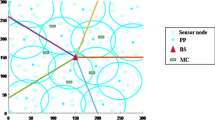Abstract
Sensor deployment is one of the most important issues in wireless sensor networks (WSNs), because an efficient deployment scheme can reduce the cost and enhance the detection capability of the WSNs. Due to packet forwarding, sensors closer to the sink consume more energy than those farther away. In this paper, we propose a sensor deployment scheme, which can achieve full coverage of the monitoring area and prolong network lifetime. We consider a real world situation where the initial energy of the sensors is different from each other. First, to achieve full coverage using as few sensors as possible, we compute the average angle between the sensor nodes. Then, we provide two methods to achieve energy balance. In the first method, we propose a sweep-based scheme to move the sensors as requested. In the second method, we transform the deployment problem into the multiple knapsack problem and based on ant colony optimization algorithm, we propose a deployment strategy to improve the network lifetime.









Similar content being viewed by others
References
Akyildiz, I. F., Su, W., Sankarasubramaniam, Y., & Cayirci, E. (2002). Wireless sensor networks: A survey. Computer Networks, 38(4), 393–422.
Boukerche, A., & Fei, X. (2007). A voronoi approach for coverage protocols in wireless sensor networks. In IEEE global telecommunications conference (GLOBECOM).
Boryczka, U. (2007). Ants and multiple knapsack problem. In IEEE computer information systems and industrial management applications (CISIM).
Cardei, M., Yang, Y., & Wu, J. (2008). Non-uniform sensor deployment in mobile wireless sensor networks. In IEEE world of wireless, mobile and multimedia networks (WoWMoM).
Chatterjee, P., & Das, N. (2014). Coverage constrained non-uniform node deployment in wireless sensor networks for load balancing. In Applications and innovations in mobile computing (AIMoC).
Chellappan, S., Bai, X., Ma, B., Xuan, D., & Xu, C. (2007). Mobility limited flip-based sensor networks deployment. IEEE Transactions of Parallel and Distributed Systems, 18(2), 199–211.
Cheng, Z., Perillo, M., & Heinzelman, W. B. (2008). General network lifetime and cost models for evaluating sensor network deployment strategies. IEEE Transactions on Mobile Computing, 7(4), 484–497.
Culler, D., Estrin, D., & Srivastava, M. (2004). Overview of sensor networks. IEEE Computer, 37(8), 41–49.
Dietrich, I., & Dressler, F. (2009). On the lifetime of wireless sensor networks. ACM Transactions on Sensor Networks, 5(1), 5.
Dorigo, M., & Gambardella, L. M. (1997). Ant colony system: A cooperative learning approach to the traveling salesman problem. IEEE Transactions on Evolutionary Computation, 1(1), 53–66.
Huang, C.-F., & Tseng, Y.-C. (2005). The coverage problem in a wireless sensor network. ACM Mobile Networks and Applications, 10(4), 519–528.
Kim, Y.-H., Kim, C.-M., Han, Y.-H., Jeong, Y.-S., & Park, D.-S. (2013). An efficient strategy of nonuniform sensor deployment in cyber physical systems. The Journal of Supercomputing, 66(1), 70–80.
Liu, C.-H., & Ssu, K.-F. (2008). A moving algorithm for non-uniform deployment in mobile sensor networks. ACM Mobile Technology Applications, and Systems.
Meguerdichian, S., Koushanfar, F., Potkonjak, M., & Srivastava, M. B. (2001). Coverage problems in wireless ad-hoc sensor networks. In IEEE international conference on computer communications (INFOCOM).
Meguerdichian, S., Koushanfar, F., Potkonjak, M., & Srivastava, M. B. (2005). Worst and best-case coverage in sensor networks. IEEE Transactions on Mobile Computing, 4(1), 84–92.
Olariu, S., & Stojmenovic, I. (2006). Design guidelines for maximizing lifetime and avoiding energy holes in sensor networks with uniform distribution and uniform reporting. In IEEE international conference on computer communications (INFOCOM).
Poduri, S., & Sukhatme, G. S. (2004). Constrained coverage for mobile sensor networks. In IEEE international conference on robotics and automation (ICRA).
Subramanian, R., & Fekri, F. (2006). Sleep scheduling and lifetime maximization in sensor networks: fundamental limits and optimal solutions. In ACM international conference on information processing in sensor networks (IPSN).
Wang, G., Cao, G., & LaPorta, T. F. (2006). Movement-assisted sensor deployment. IEEE Transactions on Mobile Computing, 5(6), 640–652.
Wang, Y.-C., Hu, C.-C., & Tseng, Y.-C. (2005). Efficient deployment algorithms for ensuring coverage and connectivity of wireless sensor networks. In IEEE international conference on wireless internet (WICON).
Wu, J., & Yang, S. (2005). SMART: A scan-based movement assisted sensor deployment method in wireless sensor networks. In IEEE international conference on computer communications (INFOCOM).
Xu, Y., Shen, L., & Yang, Q. (2009). Dynamic deployment of wireless nodes for maximizing network lifetime in WSN. In IEEE wireless communications & signal processing (WCSP).
Yang, Y., & Cardei, M. (2007). Movement- assisted sensor redeployment scheme for network lifetime increase. In ACM modeling, analysis and simulation of wireless and mobile systems (MSWIM).
Yick, J., Mukherjee, B., & Ghosal, D. (2008). Wireless sensor network survey. Computer Networks, 52(12), 2292–2330.
Acknowledgments
This work was supported in part by the National Science Council, Taiwan, under Grant MOST103-2221-E-036-016, and Tatung University, under Grant B103-N05-037.
Author information
Authors and Affiliations
Corresponding author
Rights and permissions
About this article
Cite this article
Liao, WH., Kuai, SC. & Lin, MS. An Energy-Efficient Sensor Deployment Scheme for Wireless Sensor Networks Using Ant Colony Optimization Algorithm. Wireless Pers Commun 82, 2135–2153 (2015). https://doi.org/10.1007/s11277-015-2338-x
Published:
Issue Date:
DOI: https://doi.org/10.1007/s11277-015-2338-x




